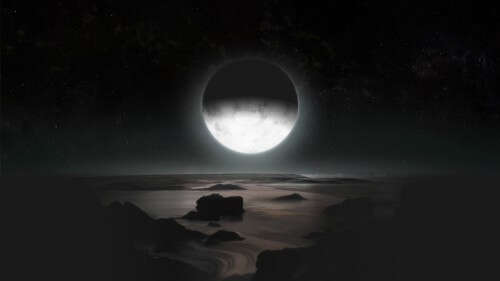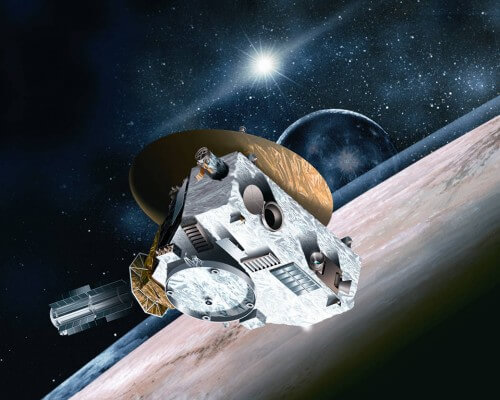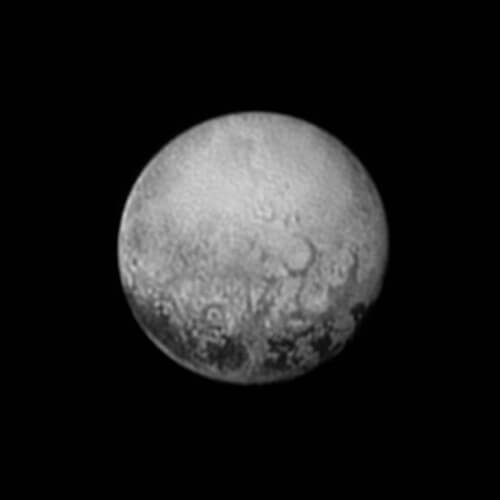The New Horizons spacecraft will pass only 12 thousand kilometers from Pluto today

Pluto is the Roman name of Hades - the god of the underworld in Greek mythology, therefore it was an appropriate name for the distant and remote planet - the coldest and darkest place in our solar system. Pluto was only discovered in 1930, and if all goes well, tomorrow (Tuesday) it will receive its first visit from Earth, when the New Horizons spacecraft will pass near it - only 12,000 km. Pluto is now about 4.5 billion km away from us - 30 times farther than the Sun - and no spacecraft has ever come close to it. Until New Horizons, its best images were obtained from the Hubble Space Telescope, and although they were enough to discover four of Pluto's five moons, they could not provide much information about Pluto's composition and surface structure.
Expect surprises
When the spacecraft set off, Pluto was still considered the ninth and smallest planet in the solar system. A few months later, its status was lowered, and it is defined as a "dwarf planet", partly due to the discovery of Eris, a body similar to Pluto in size and further away from the Sun. "Pluto is a dwarf planet composed of rocks and mostly ice. It is actually one body that represents about a thousand members of the Kuiper belt. When we study Pluto, we are actually studying the thousand most primitive bodies in the solar system, which are the icy building blocks of all the planets," says Prof. Oded Aharonson, head of the Center for Planetary Sciences at the Weizmann Institute. "One of the exciting things about "New Horizons" is the opportunity to observe for the first time such a different planetary body. In space exploration it always happens that when we arrive at new places we find surprises that we would not have imagined. It happened with the Moon, with Mars and with the moons of Jupiter and Saturn. I'm guessing it will happen again with Pluto."
One of the surprises that the spacecraft has already provided is the discovery of unexpected differences between Pluto and its large moon, Charon - named after the shuttle that takes the dead on their last journey to the underworld. The popular belief among astrophysicists is that they originated from one body, and were separated as a result of a large collision. "As we get closer to Pluto and photograph it and Charon, we see that the surface of these two bodies is composed of very different materials. Pluto is more reddish, while Charon is gray," says Aaronson. "It's really a surprise. I don't think anyone expected to find such a difference between them."

frozen summer
Because of Pluto's enormous distance from the Sun, its year (that is, one lap around the Sun), takes about 250 Earth years. In other words - since its discovery until today, it has completed only about a third of its rotation around the sun. The temperature on its surface is quite cold - about 230 degrees below zero, and the amount of sunlight that reaches it - is negligible. Nevertheless, scientists believe that there are also seasons on Pluto, especially given the fact that its orbit is very elliptical. Now it is about 4.5 billion km from the Sun - this is almost the closest point to it in its orbit. Its peak distance reaches almost 7.5 billion km (the orbit of NASA is almost a perfect circle compared to Pluto). "Scientists expect the surface and the climate to change on the surface of Pluto all the time with the changing of the seasons," Aaronson explains. "We expect that ice - that is, the frozen methane on its surface - will evaporate in one place and condense in another." According to Aaronson, there is apparently also water on Pluto - in fact, most of it is made of frozen water - but it cannot melt or evaporate in its temperature range. The photographs of New Horizons are supposed to provide a lot of new information about the composition of the surface, and possibly also a climate picture that can later be better completed with the help of other observations.

This is how world fame passes
The New Horizons spacecraft was launched from Florida in January 2006. In order to complete the tremendous journey - about six billion km, including the lap of Jupiter to gain acceleration - in less than a decade, it needs enormous speed. Indeed, she is hurtling through space at a speed of about 50,000 km/h - more than a million km a day! At this dizzying speed there is no way to stop the spacecraft without a huge amount of fuel. The fact that Pluto is a very small celestial body (its mass is only 0.2% of that of Earth), with weak gravity, does not help the slowdown. Indeed, New Horizons will not stop at Pluto at all, but will simply fly past it. In a time window of a few hours, it will be very close to it in cosmic terms, and will reach a peak proximity of about 12,000 km in the afternoon hours (Israel time) of Tuesday.
During the brief visit she is supposed to collect a huge amount of photos and information. However, due to the enormous distance, it takes about four hours for the information to reach our planet from the spacecraft. Due to the communication limitations, the large amount of information that the spacecraft will collect during the day of the transit near Pluto, it is supposed to transmit gradually over 16 months, so the scientists expect a lot of work. The spaceship itself will not sit idly by either, of course. It will continue to cruise beyond Pluto, deep into the area known as the "Kuiper belt" - an area that probably includes thousands of celestial bodies, some of them hundreds of kilometers in size, orbiting the Sun in an even farther orbit than Pluto's. "NASA has already marked several bodies that the spacecraft can approach, and study them, in an area about which we know very little," says Aaronson.
After passing through the Kuiper belt, the spacecraft will continue to advance into real space - this is the interstellar medium, that is, the area outside the solar system. The boundary of the solar system is of course not so defined and clear, and it could be years before the spacecraft reaches outside the solar system itself. The two Voyager spacecraft that were launched almost 40 years ago outside the solar system have been in the fringes for years, and scientists have not yet been able to determine whether they actually went into interstellar space. The distances in space are so great that even with the enormous speed of New Horizons it will be thousands of years before it approaches another solar system. Even if this happens, no one on Earth will be able to know about it of course - the nuclear generator that supplies her electricity will be turned off a long time ago (amusingly, the generator produces electricity from the decay of plutonium, a radioactive element that was discovered shortly after the discovery of Pluto, and therefore named after him), and if She will indeed end up somewhere else, she will be nothing but a frozen metal box. Meanwhile, this box, which weighs less than 500 kg, has carried the best technology to the edge of the solar system, and if everything works well, it will also bring back a wealth of information from there, which will teach us more briefly about the neighborhood we live in.
More of the topic in Hayadan:
- New Horizons approaches Pluto - photographed the enigmatic dark spots
- A historic meeting
- A whale on Pluto
- The discoverer of Pluto, the girl who gave him his name and the actor Leonard Nimoy will be commemorated on Pluto and its moons

4 תגובות
Cool fact I just discovered:
The Mariner 4 probe was the first to fly past Mars on July 14, 1965.
Today, the New Horizons probe will be the first to fly past Pluto, exactly 50 years later!
Nice article! I have a really tiny correction: plutonium was not "discovered" but "created" by man. There is currently no natural plutonium on earth.